
Coralline algae are red algae in the order Corallinales. They are characterized by a thallus that is hard because of calcareous deposits contained within the cell walls. The colors of these algae are most typically pink, or some other shade of red, but some species can be purple, yellow, blue, white, or gray-green. Coralline algae play an important role in the ecology of coral reefs. Sea urchins, parrot fish, and limpets and chitons feed on coralline algae. In the temperate Mediterranean Sea, coralline algae are the main builders of a typical algal reef, the Coralligène ("coralligenous"). Many are typically encrusting and rock-like, found in marine waters all over the world. Only one species lives in freshwater. Unattached specimens may form relatively smooth compact balls to warty or fruticose thalli.
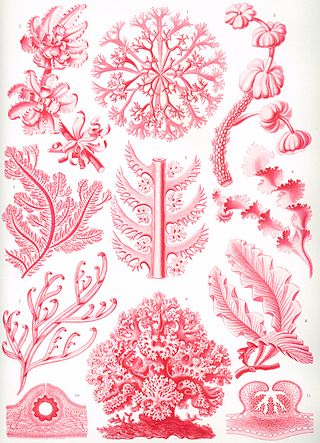
Florideophyceae is a class of exclusively multicellular red algae. They were once thought to be the only algae to bear pit connections, but these have since been found in the filamentous stage of the Bangiaceae. They were also thought only to exhibit apical growth, but there are genera known to grow by intercalary growth. Most, but not all, genera have three phases to the life cycle.

Conceptacles are specialized cavities of marine and freshwater algae that contain the reproductive organs. They are situated in the receptacle and open by a small ostiole. Conceptacles are present in Corallinaceae, and Hildenbrandiales, as well as the brown Fucales. In the Fucales there is no haploid phase in the reproductive cycle and therefore no alternation of generations. The thallus is a sporophyte. The diploid plants produce male (antheridia) and female (oogonia) gametangia by meiosis. The gametes are released into the surrounding water; after fusion, the zygote settles and begins growth.
Phymatolithon is a genus of non geniculate coralline red algae, known from the UK, and Australia. It is encrusting, flat, and unbranched; it has tetrasporangia and bisporangia borne in multiporate conceptacles. Some of its cells bear small holes in the middle; this distinctive thallus texture is termed a "Leptophytum-type" thallus surface, and has been posited as a taxonomically informative character. It periodically sloughs off its epithallus, reducing its overgrowth by algae by as much as 50% compared to bare rock.

Peyssonnelia is a genus of thalloid red alga, named after naturalist Jean-André Peyssonnel (1694–1759) It includes the algae commonly known as rumoi-iwanokawa, mayoi-iwanokawa and akase-iwanokawa. Specimens can reach around 20 cm in size. Peyssonnelia produces tetraspores.
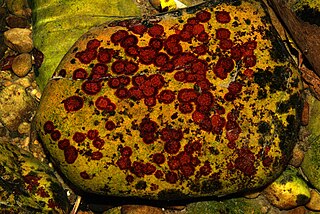
Hildenbrandiales is an order of crustose forms red alga which bear conceptacles and produce secondary pit-connections. They reproduce by vegetative gemmae as well as tetrasporangia, which are produced inside the conceptacles. The way in which the tetraspores are produced is unusual enough to justify the formation of this distinct order. Some members of the order are known from freshwater rivers as well.

Red algae, or Rhodophyta, are one of the oldest groups of eukaryotic algae. The Rhodophyta comprises one of the largest phyla of algae, containing over 7,000 currently recognized species with taxonomic revisions ongoing. The majority of species (6,793) are found in the Florideophyceae (class), and mostly consist of multicellular, marine algae, including many notable seaweeds. Red algae are abundant in marine habitats but relatively rare in freshwaters. Approximately 5% of red algae species occur in freshwater environments, with greater concentrations found in warmer areas. Except for two coastal cave dwelling species in the asexual class Cyanidiophyceae, there are no terrestrial species, which may be due to an evolutionary bottleneck in which the last common ancestor lost about 25% of its core genes and much of its evolutionary plasticity.

Apophlaea is a genus of thalloid algae that is endemic to New Zealand. This genus has two species, both from the high intertidal zone on New Zealand's coasts. Specimens can reach around 15 cm in size. The thalli take a crustose form, but also contain upright, branching frond-like protrusions that reach 5–8 cm in height. Secondary pit connections and secondary pit connectionsare present in the organisms. Apophlaea reproduces by means of conceptacles; it produces tetraspores.
Archaeolithophyllum is a genus of conceptacle-bearing red alga that falls in the coralline stem group. It somewhat resembles Lithophyllum.
Synarthrophyton is a genus of thalloid red algae comprising eight species. The monomerous, crustose thalli are composed of a single system of filaments which grow close to the underlying surface. Synarthrophyton reproduces by means of flask-shaped multiporate conceptacles; it produces tetraspores and dispores. Mucus plugs the opening of young conceptacles, which open as they mature.
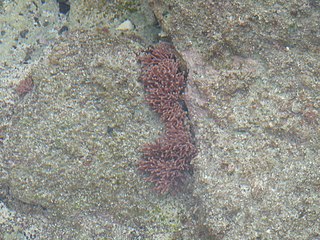
Amphiroa is a genus of thalloid red algae under the family Corallinaceae.
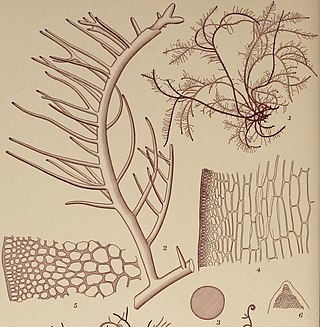
Hypnea is a genus of red algae, and a well known carrageenophyte.
Pyropia virididentata, formerly known as Porphyra virididentata, is a red alga species in the genus Pyropia. It is endemic to New Zealand. It is monostromatic, monoecious, and grows in the intertidal zone, predominantly on rock substrata. With Porphyra cinnamomea, Pyropia rakiura and Clymene coleana, they can be distinguished by morphology, as well as geographical, ecological and seasonal distribution patterns, and importantly, chromosome numbers, which in this species n = 3. Finally, these four species are distinguished by a particular nucleotide sequence at the 18S rDNA locus.
Sirodotia Kylin (1912) is a genus of freshwater red alga which was described by Kylin in 1912, and placed in the Batrachospermaceae family.

Batrachospermaceae is a family of fresh water red algae (Rhodophyta). Genera within the Batrachospermaceae generally have a "Lemanea-type" life history with carpospores germinating to produce chantransia. Sporophyte phase with meiosis occurs in an apical cell to produce the gametophyte stage. Pit connections have two pit plug cap layers with the other layer enlarged. This family of freshwater red algae is uniaxial, meaning each filament with a single apical cell. The genera included within Batrachospermaceae are listed in the table below.
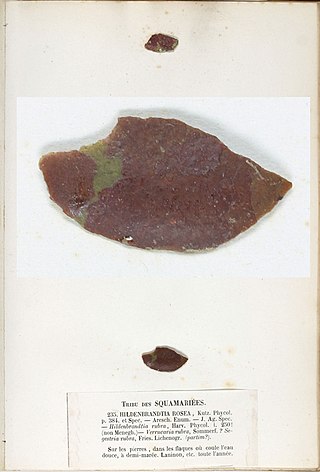
Hildenbrandia rubra is a marine species of thalloid red alga. It forms thin reddish crusts on rocks and pebbles in the intertidal zone and the shallow subtidal zone. It is a common species with a cosmopolitan distribution, and is able to tolerate a wide range of conditions.
Crustaphytum is a genus of red alga first discovered in Taoyuan algal reefs by Taiwanese scientists. The epithet “crusta” refers to crustose thallus and “phytum” refers to plant. Belonging to the family Hapalidiaceae in the order Hapalidiales, Crustaphytum is one kind of crustose coralline algae.
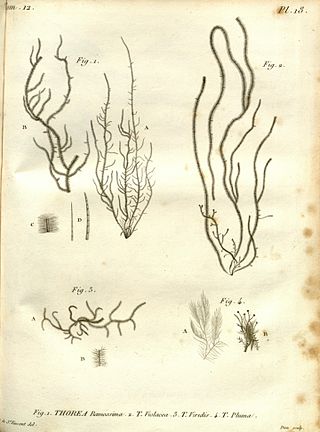
Thoreales is an order of red algae belonging to the class Florideophyceae. The order consists only one family, ThoreaceaeHassall, 1845. The family of Thoreaceae was circumscribed by Arthur Hill Hassall in A history of the British freshwater algae, including descriptions of the Desmideae and Diatomaceae in 1845.

Peyssonneliales is a monotypic order of red algae belonging to the class Florideophyceae and the subclass Rhodymeniophycidae. It contains only 1 known family, PeyssonneliaceaeDenizot, M., 1968.
Kathleen "Kay" Margaret Cole was a Canadian phycologist, known as one of the world's leading experts in the cytology of marine algae. In 1998 the Canadian Botanical Society awarded her the George Lawson Medal for lifetime achievement.













